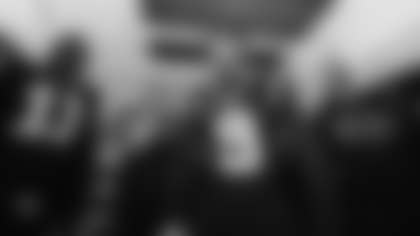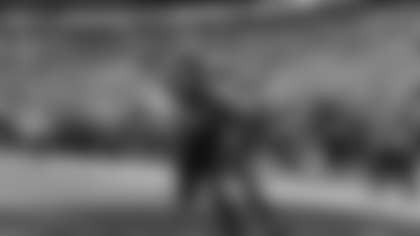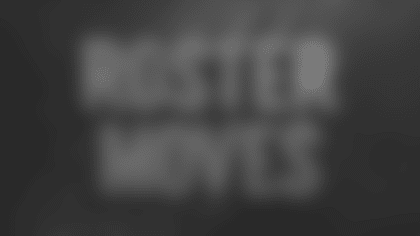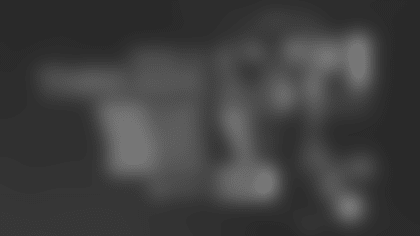Panthers right guard Austin Corbett suffered a torn left ACL on Jan. 8 in the regular season finale against the Saints. He has agreed to take us inside the rehab process, explaining his perspective on what coming back from the injury entails from a physical and an emotional standpoint and what the months of work to return actually look like as they're happening. This is his story, as it unfolds.
CHARLOTTE — For the last 269 days, Austin Corbett has been a rehab patient, perhaps a model one, but a rehab patient, nonetheless.
Today, Austin Corbett is a football player again.
The Panthers opened a 21-day window for the veteran guard to practice on Wednesday, and he'll do that this afternoon. But this morning, he went through his first walk-through with teammates since tearing his ACL during the final game of last season. For months, he's been adjacent to them in the weight room and the athletic training room. He's been near them while he worked out for three hours at a time, which overlaps but never quite coincides with practice.
Finally, he's a football player again.
There are pads in his locker, just like the rest of them. That hasn't been the case for the last eight months. There's a helmet on the hook just below his nameplate, ready for him to pull it on for a real reason later today for the first time since January.

Corbett knows there are still steps to take, but when he talked to his wife about it this week, they finally knew that goal he's been pushing toward for the last eight months and change has become tangible.
"Madison and I were talking the other night, and it's been so long, but in a way it's gone so fast," Corbett said. "There are just constant reminders of what it's been like to go through this. I know I'm not the first, and I won't be the last to tear an ACL and come back.
"There are a lot of days that are awful, sucky days. But then there are days when you make an incredible leap, and it's like, holy cow, it's amazing what the body can do."
His body has been through a lot in the last 269 days, starting with blowing out the anterior cruciate ligament in his left knee just before halftime of the final game of last season.
"As soon as I felt that valgus movement, I had a pretty good idea what happened," Corbett said two days after an MRI confirmed that he had, in fact, torn the ACL. He was able to use the medical terminology for the inward shift of the knee joint because when he enrolled at the University of Nevada, he was majoring in kinesiology and was thinking about medical school. He has insight into what's happening inside of his leg that many players don't.
So, from the start, he poured himself into the rehab process, along with the dozens of people surrounding him at Bank of America Stadium. Assistant athletic trainer Katy Rogers has been there from the start, flying with him to California for the Jan. 18 surgery to repair the ligament, and she's been a constant presence for Corbett throughout the process.

Rogers referred to the "army of people" who have been alongside Corbett every step of this process, from the lonely days when he never left the athletic training room to his first steps onto a zero-gravity treadmill to those first reps in the weight room, to meeting with doctors and nutritionists and coaches to get ready for today.
If it's an army, she's probably the general, though she quickly deflected the title, making herself just another foot soldier.
"No, that's him," Rogers said. "He's been the model patient, the model athlete. Like, he's the reason why a lot of us are doing our jobs, for cases like his. I'm super happy for him.
"It's exciting, and I think a lot of his teammates are really excited to see him back, his coaches, so it'll be a surreal moment. And I'm excited for him. It's going to be neat."
Head athletic trainer Kevin King echoed that and was quick to point out for all the people and all the technology that was mustered to get Corbett back out on the field, the biggest factor was Corbett's own approach to the rehab.
"It's been a lot of days, and he stayed true, stayed diligent, he has a routine. That's impressive," King said. "It's hard to stack a week. It's hard to stack a month. I don't even know how many days it's been, but his attention to detail and fortitude throughout this process has been really impressive.
"Because I mean, it's not just here. He lives this. He's eating different, he's sleeping different, you know, like he's committed to improve his total wellness. So it transcends everything."

All of those small steps have been in mostly familiar ways. But in recent days, as he's building up to today, he's had to get creative.
Before he could practice against an opposing force, he had to replicate what it might be like. But how do you replicate practice when you're by yourself in the bubble while the rest of them are practicing? You improvise.
In the last few days, Corbett's routine looks as much like parkour as playing in the NFL. The good news is, he's a former wrestler, so he's used to putting his body in unusual positions.
At one point, while his teammates were preparing for last week's game, Corbett was inside the Atrium Health Dome, upside down and leaning against a pad next to the wall, cranking out hand-stand pushups.
It looked like two things at once — that he was nearing readiness and that he was supremely bored.
"You got that right," Corbett said with a laugh. "You can only push a sled so many times. Back when I wrestled, when we were warming up, we'd do all these rolls and cartwheels because it was about body awareness and knowing where your body was in space. It's like playing offensive line because you never know where you're going to be.
"So we got creative with the work, to mimic being explosive in different positions."
So he might push a sled for 8 yards at high intensity, do a forward roll, get up, take a pass set, another roll, and then push the sled again. Then someone throws a medicine ball at him, he throws it back, and then he sprints.
In between, he's walking laps around the practice field while the others are working, and then he goes back at it.
At this near-to-final step of the process, he's got to build himself back to the point he can exert at a high level for three-plus hours. Practice doesn't last that long, so he's out there before the other guys start and then often still going when the rest of them are finished.
Corbett really began the on-field journey in Spartanburg when he first started pushing on a human being again and gradually found larger human beings. But as much as leaning against 195-pound sports science coordinator Ryan Bellerose and then 295-pound assistant strength and conditioning coach Corey Miller (a former University of Tennessee defensive end) helped him get here, Corbett knows when practice starts today, he'll be with the scout team, and the guys across from him will be Derrick Brown and the rest of the first defense.
"I mean, that's the test, when Derrick starts pushing on you," Corbett said. "Then you've got DeShawn Williams and Shy Tuttle, those are both quick-twitch guys with strength, and then there's Brian Burns, so you get it all.
"I'm going to have to get better quick."

He has gotten better quickly, and yet gradually at the same time. With his everyday focus, he's kept his gaze down instead of out, worrying about what's happening at that moment rather than at some abstract point in the future. It's going to be some time before he comes back (after the bye week seems like a reasonable guess), but he won't get ahead of himself now — not after 269 days of daily attention to detail.
There have been moments, however, when he felt a weight lift off him.
Last Wednesday, Corbett and his army had a call with Dr. Neal ElAttrache, the surgeon who rebuilt his left knee.
Dr. El Attrache is a busy guy; Corbett jokingly referred to him as "Doc Hollywood," but he gives his patients all his attention while he's engaged with them. So the call they were all waiting for got pushed back a few times while he was with other patients before they finally got on the phone with him. It was around 9 p.m. on the East Coast when they finally got through.
King and Rogers presented all the data they've collected over the past eight months that show Corbett's progress. In many ways, Corbett is stronger now than he was before the injury. But they needed to show the ratios of strength on his left side and his right compared to the baseline collected when he was well because he needed to be close to balanced to be cleared to go.
"By the time they got on the phone with Dr. ElAttrache and presented all the numbers, the climactic moment was almost anticlimactic.
"Practice him," the surgeon replied.

Because they all know how this process goes, everyone involved is careful not to make today a finish line. Corbett still has a lot of work to do before he goes on the field again in a game.
"The doctor wanted to be confident that the strength asymmetry was within an acceptable range," King said. "And also to see that he was able to do functional football skills without beginning to swell or be able to take on a block and handle that activity, handle more capacity. So those are things that he appreciated and gave him confidence to be able to play."
King said when he saw Corbett walking laps around the practice field the other day as he cooled down, staring out at the field, he sensed he was ready.
"He's just prowling around the field, like a Panther," King said with a laugh. "It's like, OK, it's time.
"The anticipation is high. So, you're happy, and it'll be emotional when you get someone to feel like I promised you would feel. That's the job. It's what you do, to see these people be able to do their thing."
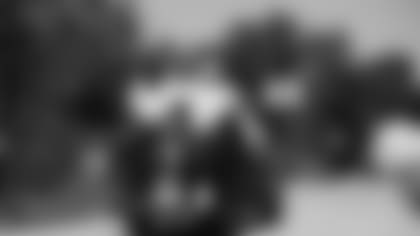
Again, today's not an end-point, and if Corbett slips up and forgets, someone will be there to remind him. It will probably be Rogers, who, if not the general, is at least his drill sergeant.
"It's a marathon, not a sprint," she said, using the football cliche in its most appropriate way ever. "But this next chapter is an exciting chapter because he gets back to the thing that he loves doing. With that comes building back up, everything that we've worked so hard on that he's worked so hard on.
"There's still a lot of recovery to be done, and that's normal for any football player, any healthy football player, let alone a person that's coming back from a major surgery. So they're still maintaining that strength and still improving strength. But now it's recovering the body even more mentally, getting him ready."
No one needs to say out loud what he's getting ready for. It's been in the back of all their minds since Jan. 8, when Corbett began this journey.
Through the weeks when he couldn't walk unassisted. Through the callouses on his hands from using crutches. Through the days of quiet moments, walking in a pool, alone with his thoughts. Through the prescribed meals, scientifically designed to keep the inflammation down. To the percentage squats, when he could bend his knees only so far, and with only so much weight. To being able to walk his dog again, or swing a golf club for the first time, or dodge his son Ford as he raced around the house. All the minor victories, major pains, and milestones that led up to today.
And then to last week, when he was so bored and so ready to get back out there, he was literally standing on his head.
"This is real now, now I'm back," Corbett said. "It's real. It's here. After all these months, I now know what the body is capable of.
"Now it's just a matter of doing it."






